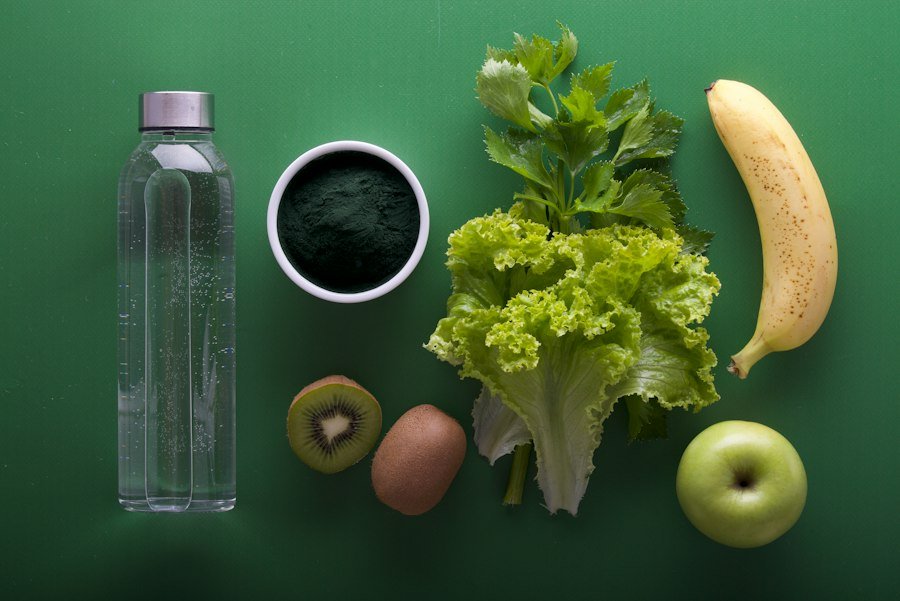Fat-burning foods are a popular topic in the world of health and nutrition. These foods are often touted as a way to boost metabolism and aid in weight loss. But what exactly are fat-burning foods?
Fat-burning foods are those that have been shown to increase the body's ability to burn fat. They are typically low in calories and high in nutrients, making them an excellent choice for those looking to lose weight or improve their overall health. Incorporating these foods into your diet can have a significant impact on your weight loss journey and overall well-being.
Key Takeaways
- Fat-burning foods can aid in weight loss by increasing metabolism and reducing appetite.
- Top 20 fat-burning foods include green tea, grapefruit, and lean protein sources.
- Incorporating fat-burning foods into your diet can lead to improved energy levels and overall health.
- Protein-rich foods play a crucial role in fat burning by preserving muscle mass and promoting satiety.
- Staying hydrated is important for fat burning as it helps to flush out toxins and support metabolic processes.
Understanding the science behind fat-burning foods
To understand how fat-burning foods work, it's essential to understand the role of metabolism in fat burning. Metabolism refers to the chemical processes that occur within the body to convert food into energy. When we consume food, our bodies break it down into its individual components, such as carbohydrates, proteins, and fats.
Fat-burning foods work by increasing the body's metabolic rate, which is the rate at which it burns calories. These foods often contain compounds that can boost metabolism, such as caffeine or capsaicin found in chili peppers. By increasing metabolism, fat-burning foods can help the body burn more calories and ultimately lead to weight loss.
How fat-burning foods can aid in weight loss
Fat-burning foods can aid in weight loss in several ways. First, they help to reduce body fat by increasing metabolism and promoting calorie burning. This can lead to a decrease in overall body weight and a reduction in body fat percentage.
Additionally, fat-burning foods are often low in calories and high in nutrients, making them an excellent choice for those looking to lose weight. By incorporating these foods into your diet, you can feel satisfied while consuming fewer calories, which can lead to weight loss over time.
Furthermore, fat-burning foods can have a positive impact on overall health. Many of these foods are rich in antioxidants, vitamins, and minerals, which can support immune function, reduce inflammation, and improve overall well-being.
Top 20 fat-burning foods
1. Green tea: Green tea is rich in antioxidants and contains compounds that can boost metabolism and promote fat burning.
2. Chili peppers: Chili peppers contain capsaicin, a compound that can increase metabolism and promote fat burning.
3. Grapefruit: Grapefruit is low in calories and high in fiber, making it an excellent choice for weight loss.
4. Berries: Berries are packed with antioxidants and fiber, making them a great choice for those looking to lose weight.
5. Salmon: Salmon is high in omega-3 fatty acids, which can help to reduce inflammation and promote fat burning.
6. Avocado: Avocado is rich in healthy fats and fiber, making it a satisfying choice for those looking to lose weight.
7. Almonds: Almonds are high in protein and healthy fats, making them a great snack for weight loss.
8. Greek yogurt: Greek yogurt is high in protein and can help to promote feelings of fullness and aid in weight loss.
9. Eggs: Eggs are a great source of protein and can help to boost metabolism and promote fat burning.
10. Spinach: Spinach is low in calories and high in nutrients, making it an excellent choice for weight loss.
11. Oatmeal: Oatmeal is high in fiber and can help to promote feelings of fullness and aid in weight loss.
12. Quinoa: Quinoa is a complete protein and can help to promote muscle growth and fat burning.
13. Lentils: Lentils are high in fiber and protein, making them a great choice for weight loss.
14. Chicken breast: Chicken breast is low in calories and high in protein, making it an excellent choice for weight loss.
15. Broccoli: Broccoli is low in calories and high in fiber, making it a great choice for weight loss.
16. Sweet potatoes: Sweet potatoes are high in fiber and can help to promote feelings of fullness and aid in weight loss.
17. Chia seeds: Chia seeds are high in fiber and can help to promote feelings of fullness and aid in weight loss.
18. Cinnamon: Cinnamon can help to regulate blood sugar levels and promote fat burning.
19. Apple cider vinegar: Apple cider vinegar can help to regulate blood sugar levels and promote fat burning.
20. Turmeric: Turmeric contains curcumin, a compound that can help to reduce inflammation and promote fat burning.
The benefits of incorporating fat-burning foods into your diet
Incorporating fat-burning foods into your diet can have numerous benefits for your health and weight loss journey.
Firstly, these foods can improve weight loss by increasing metabolism and promoting calorie burning. By consuming these foods, you can boost your body's ability to burn fat and ultimately lose weight more effectively.
Secondly, fat-burning foods are often low in calories and high in nutrients, making them an excellent choice for those looking to lose weight. By incorporating these foods into your diet, you can feel satisfied while consuming fewer calories, which can lead to weight loss over time.
Lastly, fat-burning foods are often rich in antioxidants, vitamins, and minerals, which can support immune function, reduce inflammation, and improve overall well-being. By incorporating these foods into your diet, you can improve your overall health and well-being while working towards your weight loss goals.
The role of protein-rich foods in fat burning

Protein-rich foods play a crucial role in fat burning. Protein is known to be the most satiating macronutrient, meaning it keeps you feeling full and satisfied for longer periods. This can help prevent overeating and aid in weight loss.
Additionally, protein requires more energy to digest compared to carbohydrates and fats. This is known as the thermic effect of food (TEF). The TEF of protein is higher than that of carbohydrates and fats, meaning your body burns more calories when digesting protein-rich foods.
Furthermore, protein is essential for building and maintaining lean muscle mass. Muscle is metabolically active tissue, meaning it burns more calories at rest compared to fat. By consuming protein-rich foods, you can support muscle growth and increase your metabolic rate, leading to increased fat burning.
Examples of protein-rich foods include lean meats such as chicken breast and turkey, fish like salmon and tuna, eggs, Greek yogurt, cottage cheese, and legumes like lentils and chickpeas.
The importance of hydration in fat burning
Hydration plays a crucial role in fat burning. Water is involved in many metabolic processes in the body, including the breakdown of fat. When you are dehydrated, your body's ability to burn fat decreases.
Drinking enough water can also help to suppress appetite and prevent overeating. Sometimes, thirst can be mistaken for hunger, leading to unnecessary calorie consumption. By staying hydrated, you can better differentiate between hunger and thirst and make healthier food choices.
To stay hydrated, it is recommended to drink at least eight glasses of water per day. However, individual needs may vary depending on factors such as activity level, climate, and overall health. It's important to listen to your body's thirst cues and drink water throughout the day.
In addition to water, you can also consume hydrating foods such as fruits and vegetables that have high water content. Examples include watermelon, cucumbers, strawberries, oranges, and lettuce.
How to prepare and cook fat-burning foods for maximum benefits
To maximize the benefits of fat-burning foods, it's important to prepare and cook them in a way that preserves their nutrients. Here are some tips for cooking fat-burning foods:
1. Steaming: Steaming is a gentle cooking method that helps to retain the nutrients in foods. It involves cooking food over boiling water, which helps to preserve the vitamins and minerals.
2. Grilling: Grilling is a healthy cooking method that allows excess fat to drip away from the food. This can help reduce calorie intake and promote fat burning.
3. Roasting: Roasting is a great way to bring out the natural flavors of vegetables and meats without adding excess fat or calories. It can help to enhance the taste of fat-burning foods and make them more enjoyable to eat.
4. Stir-frying: Stir-frying involves quickly cooking food in a small amount of oil over high heat. This method helps to retain the nutrients in the food while adding flavor and texture.
5. Raw: Some fat-burning foods, such as fruits and vegetables, are best consumed raw to preserve their nutrients. Raw foods are also often lower in calories and can help promote weight loss.
Combining fat-burning foods with exercise for optimal results
While incorporating fat-burning foods into your diet can aid in weight loss, combining them with regular exercise can further enhance your results. Exercise helps to increase metabolism, build lean muscle mass, and burn calories.
Cardiovascular exercises such as running, cycling, swimming, or dancing can help to burn calories and promote fat loss. Aim for at least 150 minutes of moderate-intensity cardio per week or 75 minutes of vigorous-intensity cardio per week.
In addition to cardio, strength training exercises are also important for fat burning. Strength training helps to build lean muscle mass, which increases your metabolic rate and promotes fat burning even at rest. Aim for at least two days of strength training per week, targeting all major muscle groups.
To optimize fat burning, it's important to find a balance between cardio and strength training exercises. Incorporating both types of exercise into your routine can help you achieve optimal results and improve overall health.
Tips for incorporating fat-burning foods into your daily diet
Incorporating fat-burning foods into your daily diet doesn't have to be complicated. Here are some simple tips to help you add these foods to your meals:
1. Start your day with a protein-rich breakfast: Include foods such as eggs, Greek yogurt, or a protein smoothie to kickstart your metabolism and keep you feeling full throughout the morning.
2. Include a serving of vegetables with every meal: Vegetables are low in calories and high in fiber, making them an excellent choice for weight loss. Add them to your meals as a side dish or incorporate them into recipes.
3. Snack on nuts and seeds: Nuts and seeds are high in healthy fats and protein, making them a great choice for a satisfying snack. Keep a small portion of almonds, walnuts, or pumpkin seeds on hand for when hunger strikes.
4. Swap refined grains for whole grains: Whole grains such as quinoa, brown rice, and whole wheat bread are higher in fiber and nutrients compared to refined grains. They can help to promote feelings of fullness and aid in weight loss.
5. Stay hydrated: Drink water throughout the day and include hydrating foods such as fruits and vegetables in your meals.
When eating out, make healthy food choices by opting for grilled or steamed options instead of fried foods. Choose lean protein sources such as chicken or fish and include a side of vegetables or a salad.
Incorporating fat-burning foods into your diet can have numerous benefits for weight loss and overall health. These foods can increase metabolism, promote fat burning, and provide essential nutrients for optimal well-being. By understanding the science behind fat burning and incorporating these foods into your daily diet, you can achieve your weight loss goals and improve your overall health. Remember to combine fat-burning foods with regular exercise and make healthy food choices when eating out for optimal results.
If you're interested in learning about the mental benefits of martial arts and how it can improve your mindset, check out this article on "The Mental Benefits of Judo: How This Martial Art Can Improve Your Mindset." It explores how practicing judo can enhance mental resilience, discipline, and focus. Discover how this ancient martial art can help you develop a strong mindset and overcome challenges both on and off the mat. (source)
FAQs
What is the article about?
The article is about 20 foods that can help burn fat.
What are some examples of foods that burn fat?
Some examples of foods that burn fat include avocado, green tea, salmon, almonds, and grapefruit.
How do these foods help burn fat?
These foods help burn fat by boosting metabolism, reducing appetite, and increasing the body's ability to burn fat.
Are these foods low in calories?
Most of these foods are low in calories, making them a great addition to a weight loss diet.
Can these foods be eaten in unlimited quantities?
No, even though these foods are healthy and can help burn fat, they should still be consumed in moderation as part of a balanced diet.
Can these foods be eaten raw or do they need to be cooked?
These foods can be eaten raw or cooked, depending on personal preference and the specific food.
Are these foods suitable for vegetarians and vegans?
Most of these foods are suitable for vegetarians and vegans, but some, such as salmon, are not.
Can these foods be eaten at any time of the day?
Yes, these foods can be eaten at any time of the day, but it is important to consume them as part of a balanced diet.
Do these foods have any other health benefits?
Yes, many of these foods have other health benefits, such as reducing inflammation, improving heart health, and boosting brain function.














